Viscoelastic Mechanical Responses of HMAP under Moving Load
Abstract
:1. Introduction
2. Dynamic Modulus Testing
2.1. Materials
2.2. Aggregate Gradation
2.3. Testing Results
2.4. Wheel Tracking Test
3. Viscoelastic Parameters of High-Modulus Asphalt Mixture (HMAM)
3.1. Master Curves of Storage Modulus
3.2. Maxwell Model Parameters
4. Calculation of Mechanical Responses of Viscoelastic HMAP under Moving Load
4.1. 3D Viscoelastic Finite Element Model (FEM) of Pavement under Moving Load
4.2. Mechanical Responses of Pavement Structures
4.2.1. Vertical Deformations at Road Surface
4.2.2. Shearing Strains of Middle Surface Layers
4.2.3. Stresses and Strains at Bottom of Underlayers
4.2.4. Compressive Strains at Top Center of Subgrades
4.3. Sensitivity of HMAP to Level of Loads
5. Conclusions
- (1)
- The wheel tracking test results indicate that the addition of the high-modulus modifiers can improve the high-temperature stability of the pavement. Dynamic modulus tests were successfully conducted to obtain the viscoelastic parameters and study the mechanical properties of the HMAM. The results will be helpful in interpreting the modifier behavior by explaining the change laws in the viscoelastic parameters with the loading temperature and frequency.
- (2)
- The changing rates of the storage modulus curves of the HMAM were slower than those of other asphalt mixtures, which mean that the HMAP were insensitive to the variation of the speeds of the driving load.
- (3)
- The impacts of the viscoelasticity on the mechanical responses of different pavements were identified, and the process of the mechanical responses was represented by the suggested model. The vertical deformations of the road surface, the shearing strains of the middle surface layer, the vertical strains of the underlayer, and the compressive strains of the subgrade of the two HMAP were significantly lower than those of two other pavements, and the two HMAPs perform well against the deformations. The alternating change of pull-pressure occurs at the bottom of the asphalt layer after loading and a typical asymmetric distribution appears on both sides of the curves due to the viscoelasticity of the asphalt mixtures.
- (4)
- The tensile strain and stress at the bottom of the underlayer of the HMAM-H7686 pavement do not decrease with the increase of the dynamic modulus, illustrating that the change laws of the tensile strain and stress are affected by the range of the dynamic modulus. The HMAM-H7686 pavements have the highest tensile strain, followed by the Asphalt mix-70 penetration pavements, the Asphalt mix-SBS pavements and the HMAM-Lubao pavement. The tensile strains at the bottom of the under layer cannot be effectively reduced by the HMAM-H7686, which has the highest dynamic modulus. There were obvious excessive tensile stress at the bottom of the underlayer for the HMAM-H7686 pavement, and the tensile stresses was about 70%, 110% higher than those of the HMAM-Lubao pavements and the Asphalt mix-70 penetration pavements, respectively. In conclusion, the range of the modulus of the materials must be controlled to avoid cracking at the bottom of the layer when the HMAM is selected.
- (5)
- The load levels have great effects on the mechanical responses, and the degrees to which the mechanical response is affected by different load levels were discussed in detail. The HMAP is insensitive to the load changes and could better withstand the adverse effects of the heavy load. But the increasing rates of more than 42% of the tensile strain at the bottom of the underlayer of the HMAP were similar to other pavements, which means that the tensile stress at the bottom of the asphalt layer is more serious as the loads increase, and the bottom of the asphalt layer is more prone to cracking.
Author Contributions
Funding
Acknowledgments
Conflicts of Interest
References
- Tian, W.Q.; Zhou, B.; Cong, L. High-temperature performance of modified asphalt mixture and its evaluation method. J. Build. Mater. 2009, 12, 285–287. [Google Scholar]
- Yang, C.; Xie, J.; Zhou, X.J.; Liu, Q.T.; Pang, L. Performance Evaluation and Improving Mechanisms of Diatomite-Modified Asphalt Mixture. Materials 2018, 11, 686. [Google Scholar] [CrossRef] [PubMed]
- Pasetto, M.; Baldo, N. Resistance to Permanent Deformation of Road and Airport High Performance Asphalt Concrete Base Courses. Adv. Mater. Res. 2013, 723, 9. [Google Scholar] [CrossRef]
- Huang, C.W.; Alrub, R.K.A.; Masad, E.A. Three-Dimensional Simulations of Asphalt Pavement Permanent Deformation Using a Nonlinear Viscoelastic and Viscoplastic Model. J. Mater. Civ. Eng. 2011, 23, 56–68. [Google Scholar] [CrossRef]
- Sha, A.M.; Zhou, Q.H.; Yang, Q. High modulus asphalt concrete material composition design method. J. Changan Univ. Nat. Sci. Ed. 2009, 3, 1–5. [Google Scholar]
- Moreno, F.; Sol, M.; Tomás, E. High-Modulus Asphalt Mixtures Modified with Acrylic Fibers for Their Use in Pavements under Severe Climate Conditions. J. Cold Regions Eng. 2016, 30, 04016003. [Google Scholar] [CrossRef]
- Zhen, Y.E. Asphalt Pavement Structure Layer Selection and Evaluation Model Based on Analytic Hierarchy Process. Res. Appl. Build. Mater. 2014, 2, 14–17. [Google Scholar]
- Wang, G.; Liu, L.P.; Sun, L.J. Study on the deformation resistance of high modulus asphalt concrete. J. Tongji Univ. Nat Sci. Ed. 2012, 40, 217–222. [Google Scholar]
- Liu, P.; Xing, Q.; Wang, D.; Oeser, M. Application of Dynamic Analysis in Semi-Analytical Finite Element Method. Materials 2017, 10, 1010. [Google Scholar] [CrossRef]
- Li, H.B. Performance Study of High Modulus Asphalt Mixture and Response Analysis of Pavement Structure. Highw. Eng. 2014, 6, 100–102. [Google Scholar]
- Zhang, X.Y.; Wang, R.L. Study on mechanical response of high modulus asphalt mixture pavement. Inner Mong. Highw. Transp. 2016, 3, 1–3. [Google Scholar]
- Zhou, C.J. Analysis of the Structural Response of Liaoning Provincial Governor under Heavy Load of Asphalt Pavement. Ph.D. Thesis, Harbin Institute of Technology, Harbin, China, June 2009. [Google Scholar]
- Gao, M. Analysis on the influence of high modulus asphalt concrete on high temperature stress of asphalt pavement structure. J. China Foreign Highw. 2018, 1, 283–287. [Google Scholar]
- Jurowski, K.; Grzeszczyk, S. Influence of Selected Factors on the Relationship between the Dynamic Elastic Modulus and Compressive Strength of Concrete. Materials 2018, 11, 477. [Google Scholar] [CrossRef] [PubMed]
- Moreno-Navarro, F.; Sol-Sánchez, M.; Rubio-Gámez, M.C.; Segarra-Martínez, M. The use of additives for the improvement of the mechanical behavior of high modulus asphalt mixes. Const. Build. Mater. 2014, 70, 65–70. [Google Scholar] [CrossRef]
- Lee, H.J.; Lee, J.H.; Park, H.M. Performance evaluation of high modulus asphalt mixtures for long life asphalt pavements. Const. Build. Mater. 2007, 21, 1079–1087. [Google Scholar] [CrossRef]
- Motamed, A.; Bhasin, A.; Liechti, K.M. Constitutive modeling of the nonlinearly viscoelastic response of asphalt binders; incorporating three-dimensional effects. Mech. Time-Depend. Mater. 2013, 17, 83–109. [Google Scholar] [CrossRef]
- Kumar, S.A.; Alagappan, P.; Krishnan, J.M.; Veeraragavan, A. Mechanical Response of Modified Asphalt Pavements. Congr. Transp. Dev. Inst. 2011, 438–448. [Google Scholar] [CrossRef]
- Qiu, Z.P. Numerical simulation of rutting behavior of high modulus asphalt concrete pavement. Ph.D. Thesis, Chang’an University, Xian, China, May 2009. [Google Scholar]
- Zheng, M.; Han, L.; Wang, C.; Xu, Z.; Li, H.; Ma, Q. Simulation of Permanent Deformation in High-Modulus Asphalt Pavement with Sloped and Horizontally Curved Alignment. Appl. Sci. 2017, 7, 331. [Google Scholar] [CrossRef]
- Espersson, M. Effect in the high modulus asphalt concrete with the temperature. Const. Build. Mater. 2014, 71, 638–643. [Google Scholar] [CrossRef]
- Woodroofe, J.H.F.; Leblanc, P.A. Heavy vehicle axle dynamics; rig development instrumentation. In Proceedings of the International Symposium on Heavy Vehicle Weights and Dimensions, Kelowna, BC, Canada, 8–13 June 1988. [Google Scholar]
- Al-Qadi, I.L.; Wang, H.; et al. Dynamic Analysis and In Situ Validation of Perpetual Pavement Response to Vehicular Loading. Transp. Res. Rec. 2008, 2087, 29–39. [Google Scholar] [CrossRef]
- Sarkar, A. Numerical comparison of flexible pavement dynamic response under different axles. Int. J. Pavement Eng. 2016, 17, 377–387. [Google Scholar] [CrossRef]
- Papagiannakis, A.T.; Amoah, N.; Taha, R. Formulation for Viscoelastic Response of Pavements under Moving Dynamic Loads. J. Transp. Eng. 1996, 122, 140–145. [Google Scholar] [CrossRef]
- Siddharthan, R.V.; Yao, J.; Sebaaly, P.E. Pavement Strain from Moving Dynamic 3D Load Distribution. J. Transp. Eng. 1998, 124, 557–566. [Google Scholar] [CrossRef]
- Vaitkus, A.; Paliukaitė, M. Evaluation of Time Loading Influence on Asphalt Pavement Rutting. Procedia Eng. 2013, 57, 1205–1212. [Google Scholar]
- Zhang, H.Z.; Ren, J.D.; Ji, L. Full scale mechanical response of asphalt pavement is measured and simulated. J. Harbin Inst. Technol. 2016, 48, 41–48. [Google Scholar]
- Huang, Z.Y.; Chen, Y.W.; Yan, K.Z.; Zhou, J. Dynamic response analysis of viscoelastic asphalt pavement under the action of moving load of heterogeneous distribution. J. Chongqing Jiaotong Univ. Nat. Sci. Ed. 2017, 36, 30–35. [Google Scholar]
- Dong, Z.J.; Tan, Y.Q.; Ou, J.P. Dynamic response analysis of asphalt pavement under the action of moving load of three-direction non-uniform distribution. J. civ. Eng. 2013, 6, 122–130. [Google Scholar]
- Kim, J. General Viscoelastic Solutions for Multilayered Systems Subjected to Static and Moving Loads. J. Mater. Civ. Eng. 2011, 23, 1007–1016. [Google Scholar] [CrossRef]
- Park, S.W.; Schapery, R.A. Methods of interconversion between linear viscoelastic material functions. Part I—A numerical method based on Prony series. Int. J. Solids Struct. 1999, 36, 1653–1675. [Google Scholar] [CrossRef]
- Mun, S.; Zi, G. Modeling the viscoelastic function of asphalt concrete using a spectrum method. Mech. Time-Depend. Mater. 2010, 14, 191–202. [Google Scholar] [CrossRef]
- Sun, L.; Zhu, Y. A serial two-stage viscoelastic–viscoplastic constitutive model with thermodynamical consistency for characterizing time-dependent deformation behavior of asphalt concrete mixtures. Const. Build. Mater. 2013, 40, 584–595. [Google Scholar] [CrossRef]
- Zhao, Y.Q.; Wu, J.; Wen, J. Fatigue Performance of Bridge Deck Pavement Materials. Determ. Anal. Dyn. Modul. Princ. Curve Asph. Mix. 2006, 8, 163–167. [Google Scholar]
- Wang, H.P.; Yang, J.; Shi, X.Q. Study on dynamic modulus and principal curve of high modulus asphalt mixture. Highw. Transp. Technol. 2015, 32, 12–17. [Google Scholar]
- Chen, H.; Luo, R.; Liu, H.Q. Dynamic modulus and phase Angle principal curves of asphalt mixture are studied based on generalized sigmoid model. Wuhan Univ. Technol. Transp. Sci. Eng. 2017, 41, 141–145. [Google Scholar]
- Zhao, Y.Q.; Tang, J.M.; Bai, L. Study on slack modulus of asphalt mixture by complex modulus. J. Build. Mater. 2012, 15, 498–502. [Google Scholar]
- Mun, S.; Chehab, G.; Kim, Y.R. Determination of Time-domain Viscoelastic Functions using Optimized Interconversion Techniques. Road Mater. Pavement Des. 2007, 8, 351–365. [Google Scholar] [CrossRef]
- Ghoreishy, M.H.R. Determination of the parameters of the Prony series in hyper-viscoelastic material models using the finite element method. Mater. Des. 2012, 35, 791–797. [Google Scholar] [CrossRef]
- Osborne, M.R.; Smyth, G.K. A Modified Prony Algorithm For Exponential Function Fitting. SIAM J. Sci. Comp. 1995, 16, 119–138. [Google Scholar] [CrossRef]
- Park, S.W.; Kim, Y.R. Fitting Prony-Series Viscoelastic Models with Power-Law Presmoothing. J. Mater. Civ. Eng. 2001, 13, 26–32. [Google Scholar] [CrossRef]
- Schapery, R.A. A Simple Collocation Method for Fitting Viscoelastic Models to Experimental Data. Available online: http://resolver.caltech.edu/CaltechAUTHORS:20141114-115330896 (accessed on 6 December 2018).
- Yang, C.F.; Wang, L. Dynamic response analysis of asphalt pavement under moving non-uniform load. Subgrade Eng. 2012, 5, 93–95. [Google Scholar]
- Yoo, P.J.; Al-Qadi, I.L.; Elseifi, M.A. Flexible pavement responses to different loading amplitudes considering layer interface condition and lateral shear forces. Int. J. Pavement Eng. 2006, 7, 14. [Google Scholar] [CrossRef]
- Weissman, S.L. Influence of tire-pavement contact stress distribution on development of distress mechanisms in pavements. Transp. Res. Rec. 1999, 1655, 161–167. [Google Scholar] [CrossRef]
- Zhao, Y.Q.; Zhou, C.H.; Wang, G.Z. Analysis of viscoelastic response of asphalt pavement under impulse load. J. Dalian Univ. Technol. 2011, 51, 73–77. [Google Scholar]
- Zhao, Y.Q.; Zhong, Y. Analysis of dynamic viscoelastic response of asphalt pavement. Vib. Impact 2009, 28, 159–162. [Google Scholar]
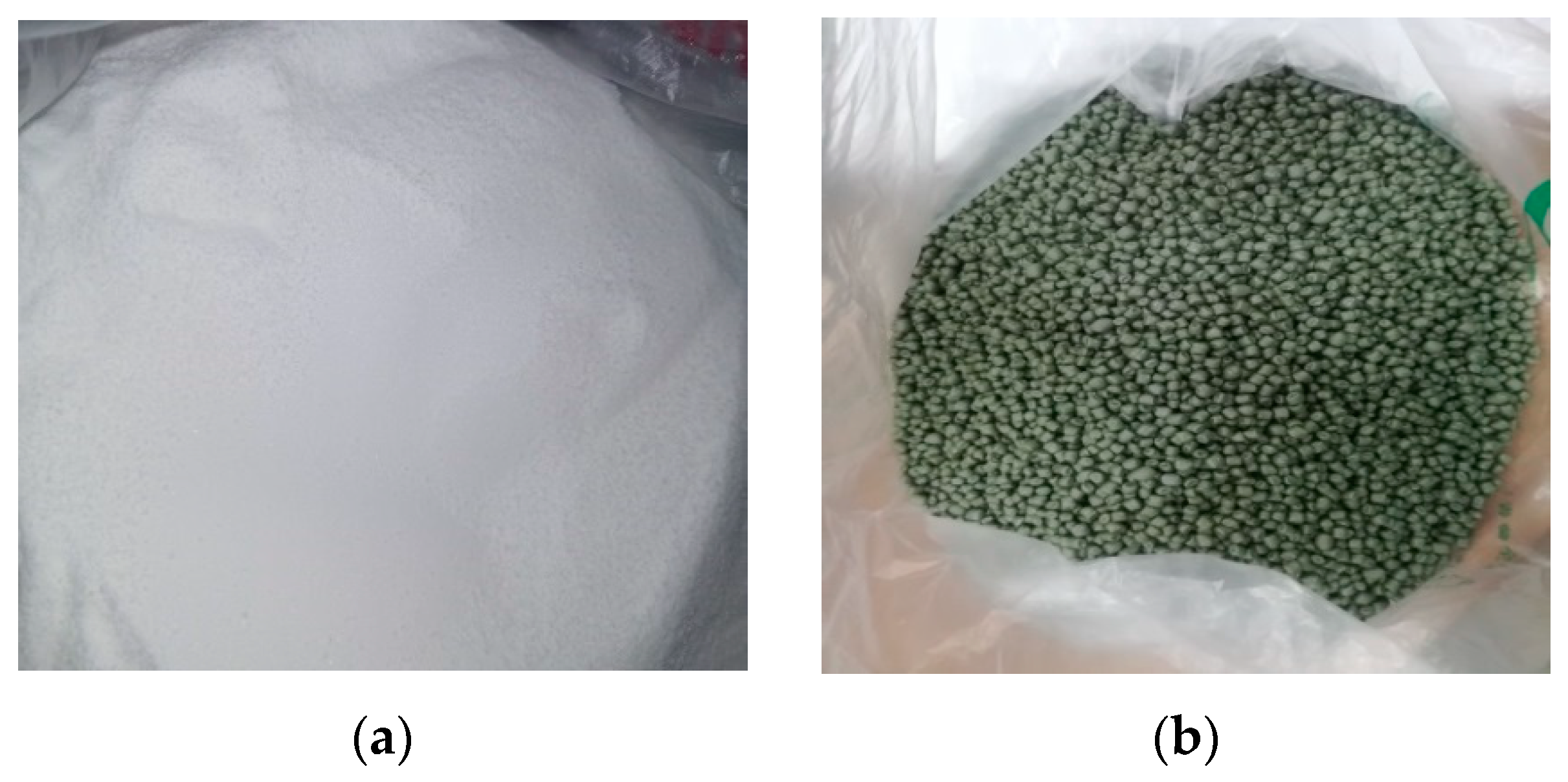
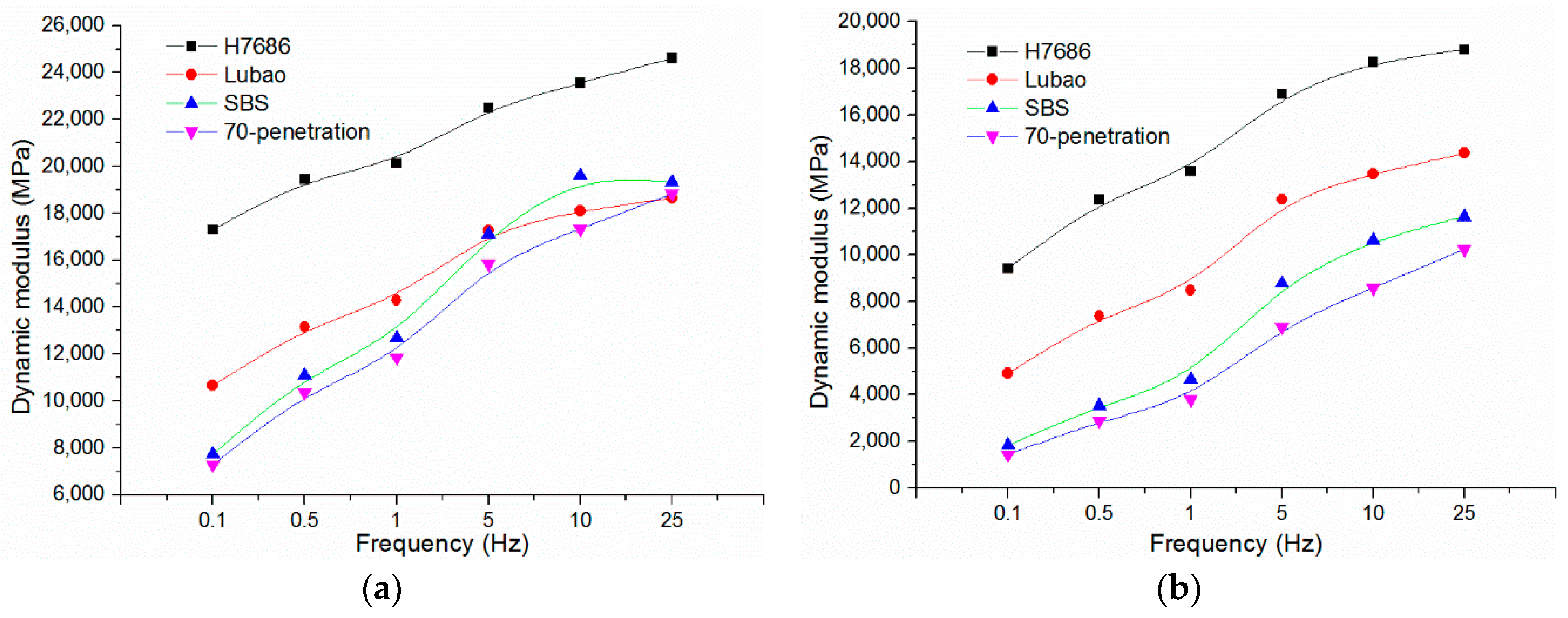
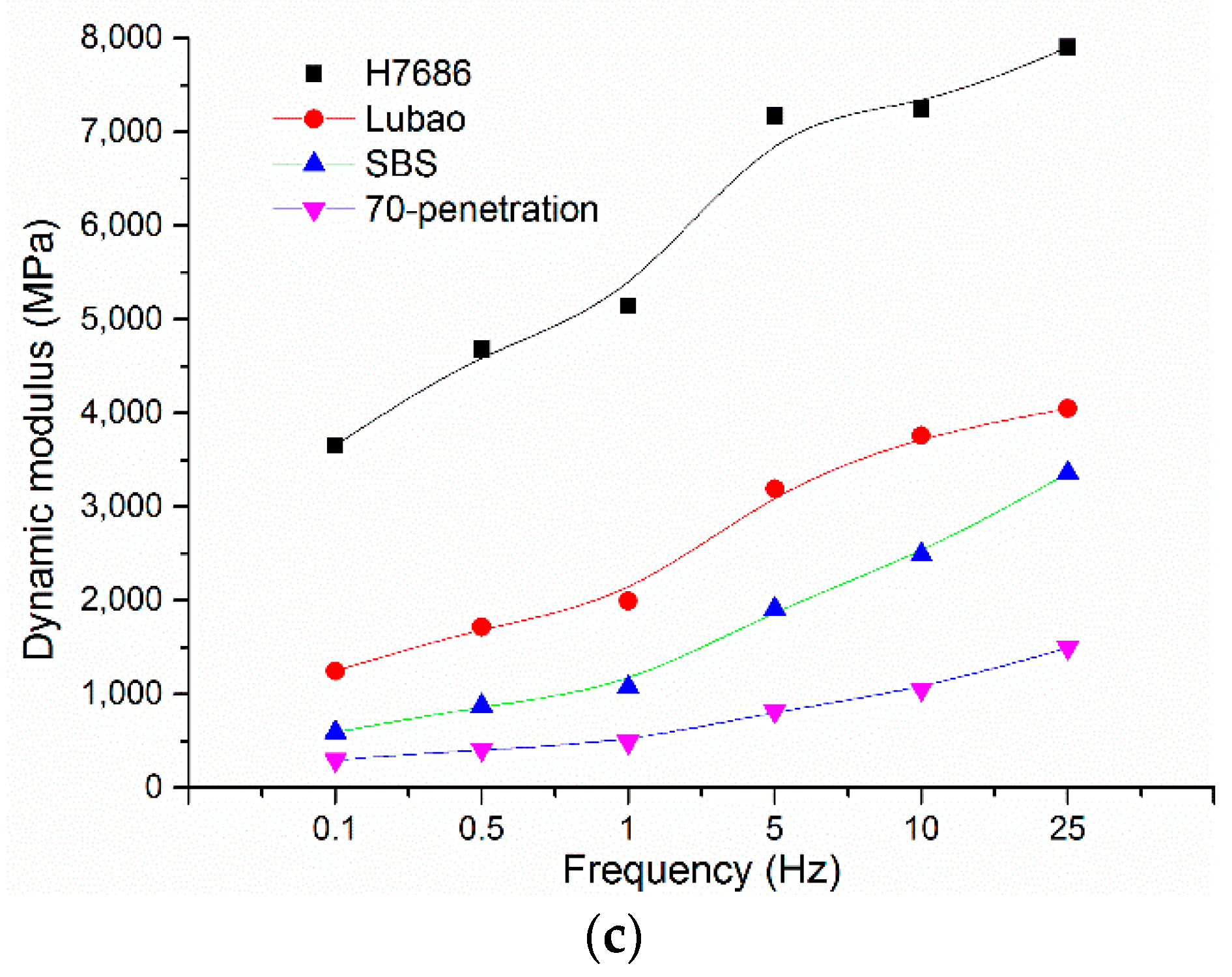
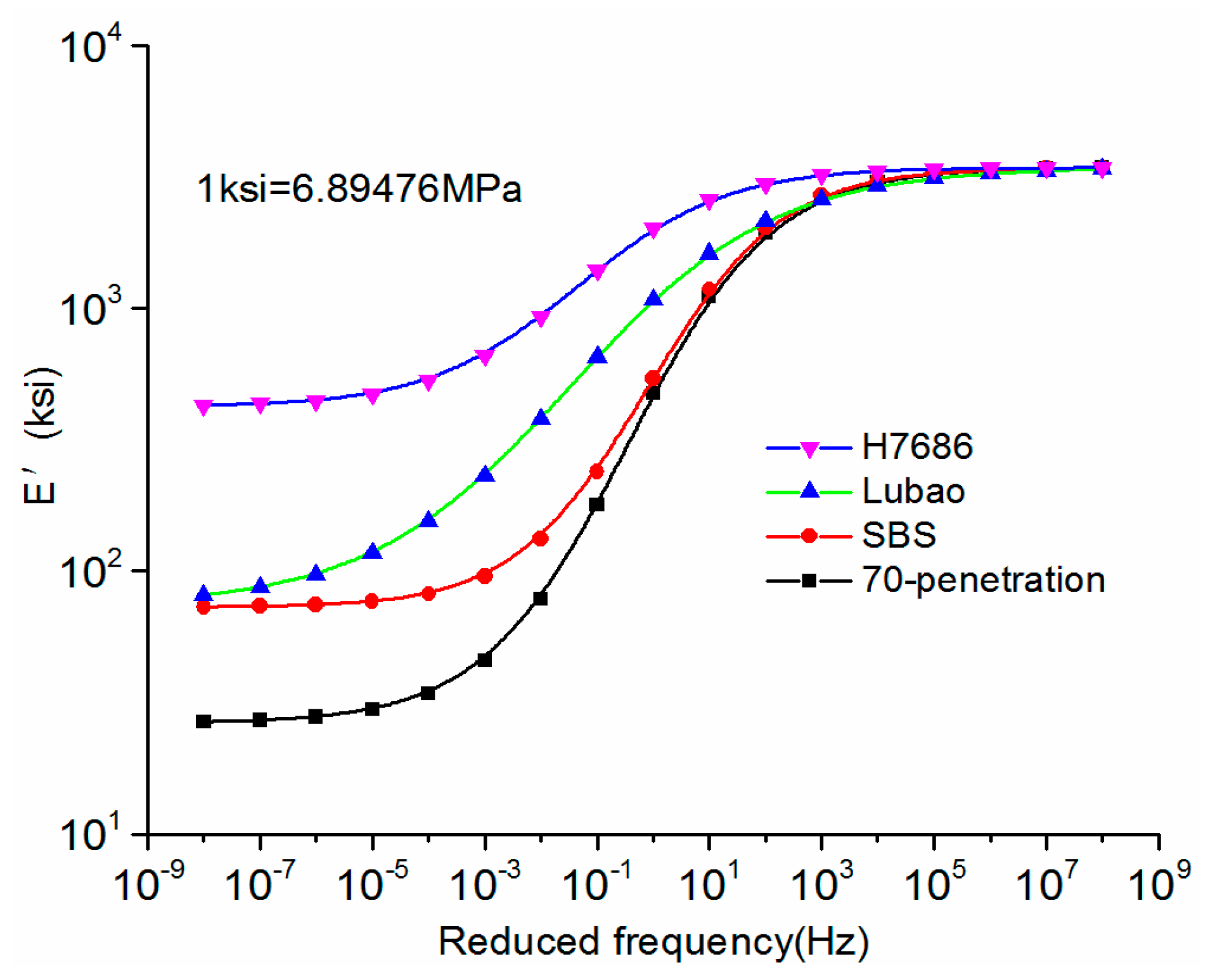
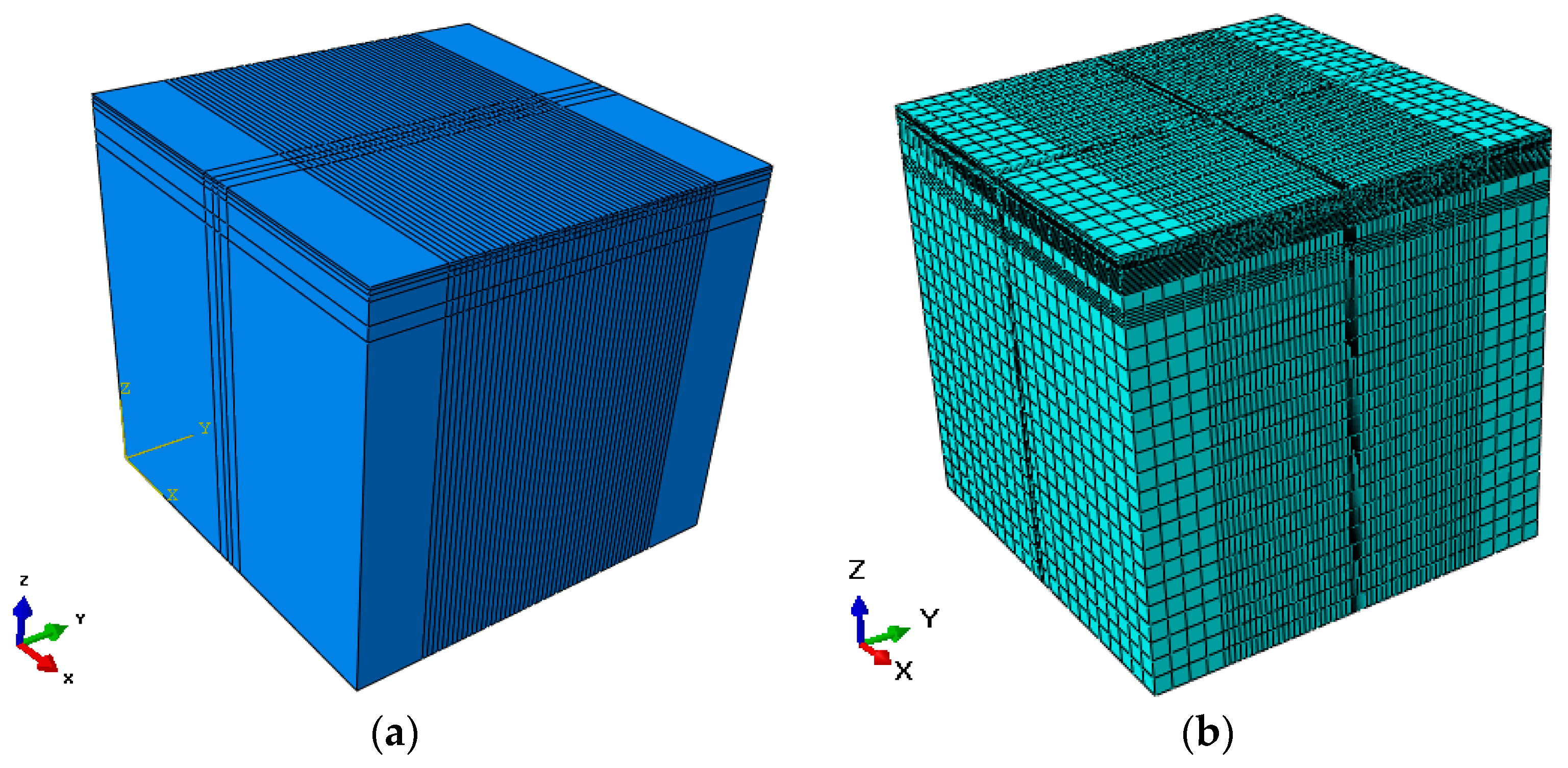
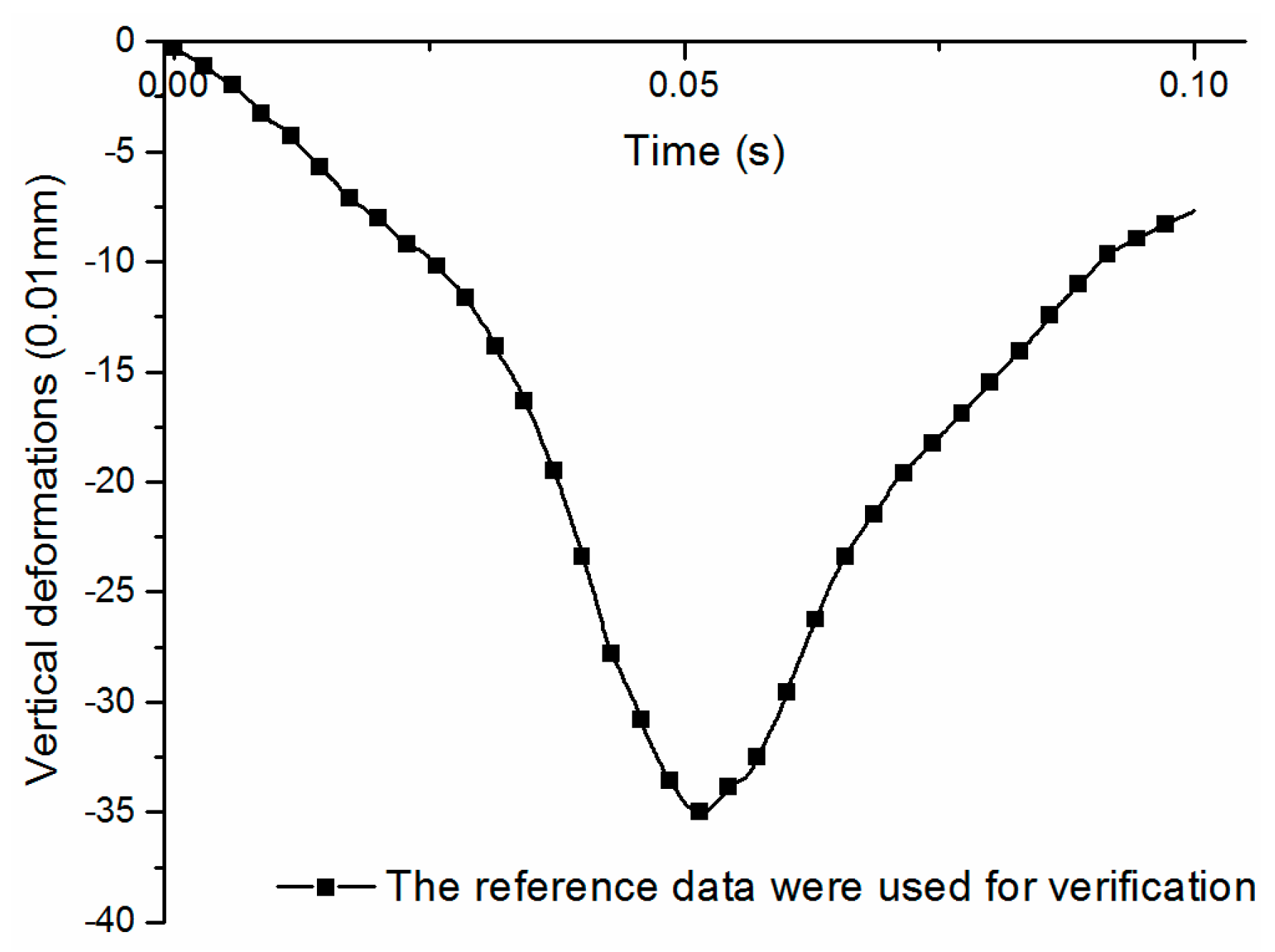

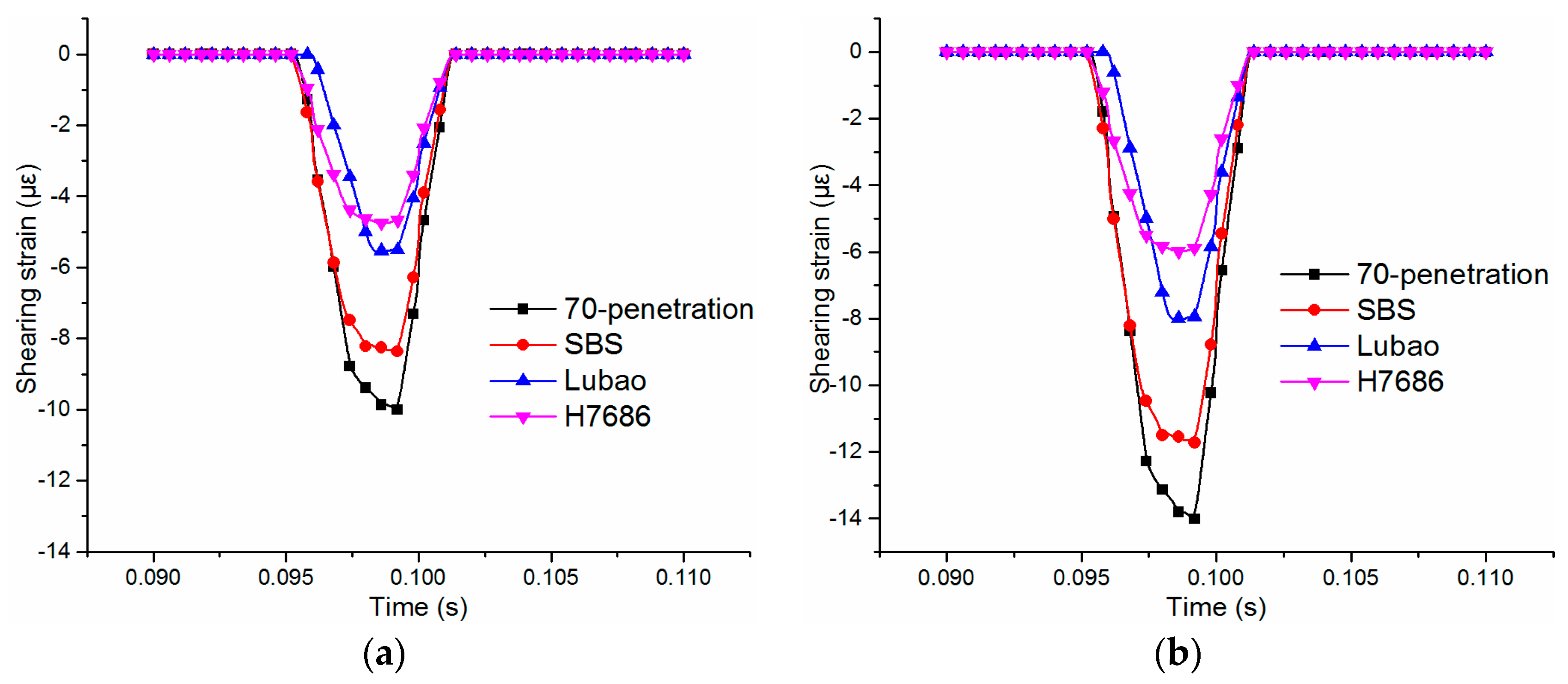
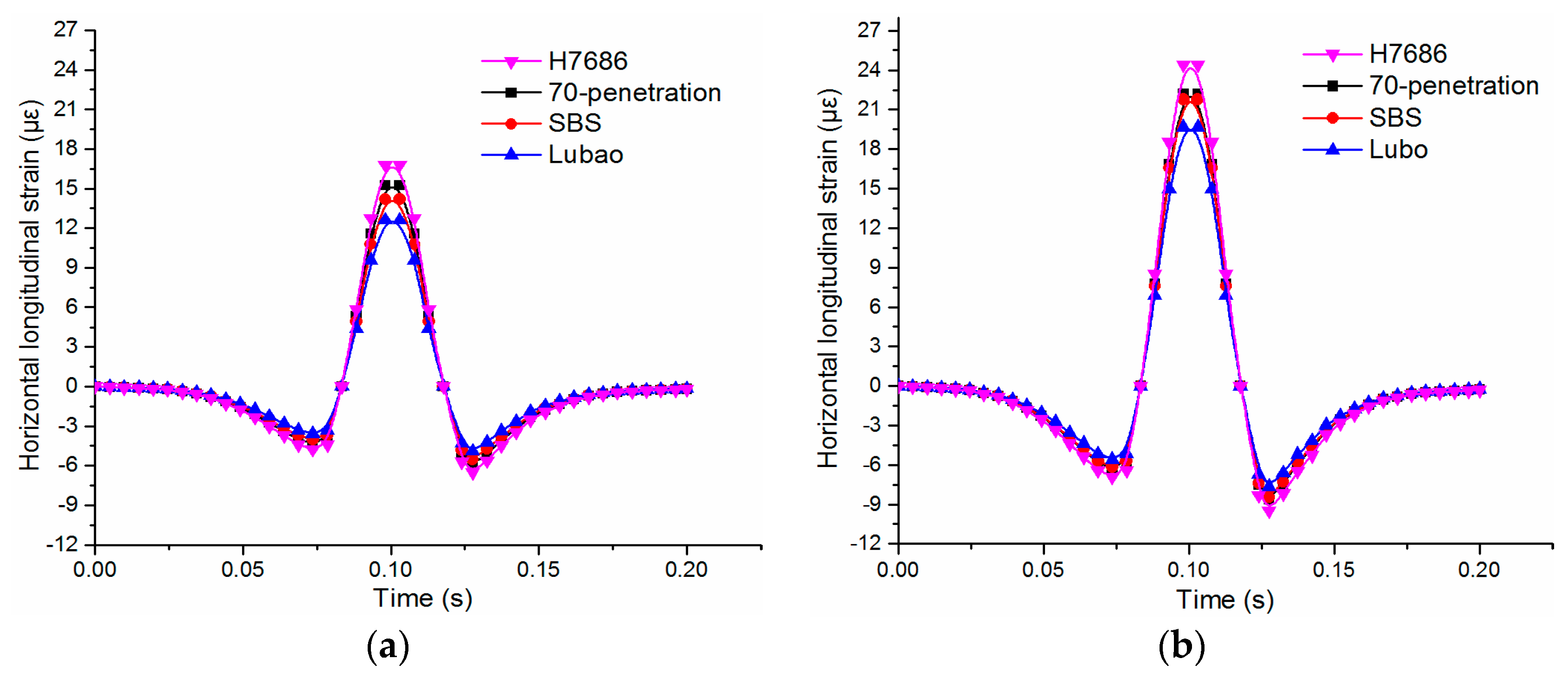
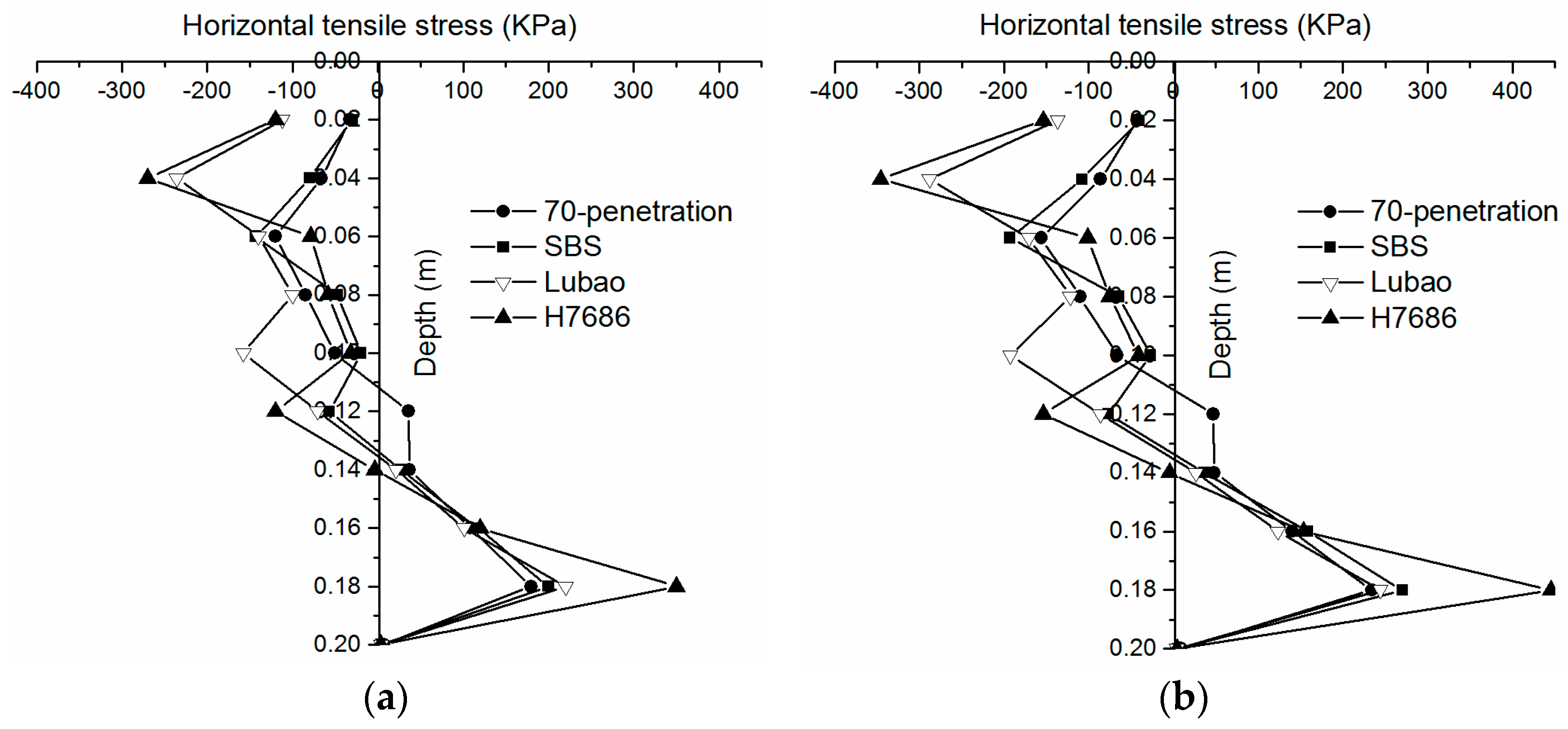
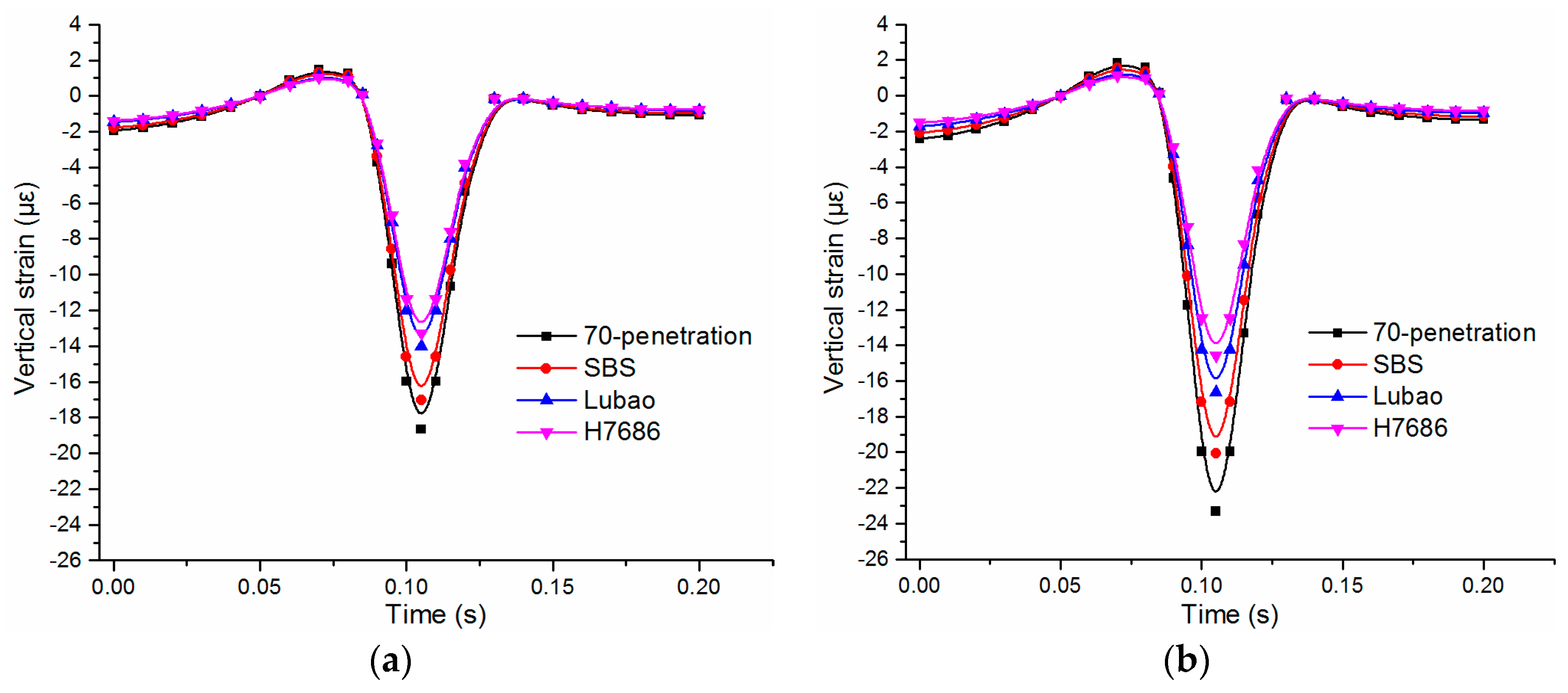

| Properties | Unit | Value | Method |
|---|---|---|---|
| Penetration (25 °C, 100 g, 5 s) | 0.1 mm | 63.2 | T0604-2011 |
| Softening Point | °C | 49.1 | T0606-2011 |
| Ductility (5 cm/min, 15 °C) | cm | >100 | T0605-2011 |
| Viscosity (177 °C) | Pa·s | 3.8 | T0625-2011 |
| Properties | Unit | Value | Method |
|---|---|---|---|
| Penetration (25 °C, 100 g, 5 s) | 0.1 mm | 50.7 | T0604-2011 |
| Softening Point | °C | 75.6 | T0606-2011 |
| Ductility (5 cm/min, 15 °C) | cm | >200 | T0605-2011 |
| Viscosity (177 °C) | Pa·s | 4.1 | T0625-2011 |
| Properties | Unit | Value |
|---|---|---|
| Droplet Point | °C | 130–138 |
| Viscosity—150 °C Brookfield | Pa·s | 4.1–4.8 |
| Properties | Value | Standards |
|---|---|---|
| Tensile Strength/MPa | 18.8 | 18–20 |
| Elongation at Break/% | 102.8 | ≥100 |
| Density/(g·cm−3) | 0.94 | 0.93–0.96 |
| Melt Flow Rate/(g/10min) | 1.2 | 1–4 |
| Vicat Softening Temperature/°C | 61.7 | ≤140 |
| Resin Content/% | 98.89 | ≥95 |
| Particle Diameter/mm | 3.7 | 3–5 |
| Sieve Size/mm | Upper Limit/% | Lower Limit/% | Gradation/% |
|---|---|---|---|
| 26.5 | 100 | 100 | 100 |
| 19 | 100 | 90 | 93.7 |
| 16 | 92 | 78 | 86.3 |
| 13.2 | 80 | 62 | 79.2 |
| 9.5 | 72 | 50 | 66.3 |
| 4.75 | 56 | 26 | 45.9 |
| 2.36 | 44 | 16 | 28.1 |
| 1.18 | 33 | 12 | 20.0 |
| 0.6 | 24 | 8 | 13.2 |
| 0.3 | 17 | 5 | 8.1 |
| 0.15 | 13 | 4 | 5.4 |
| 0.075 | 7 | 3 | 3.6 |
| Materials | Asphalt Contents/% | Relative Bulk Volume Density/g·cm−3 | Air Voids/% | Stability/kN | Flow Value/mm |
|---|---|---|---|---|---|
| Asphalt mix-70 Penetration | 4.4 | 2.422 | 4.1 | 14.2 | 3.07 |
| HMAM-Lubao | 4.6 | 2.417 | 3.8 | 22.5 | 3.77 |
| HMAM-H7686 | 4.5 | 2.420 | 3.9 | 21.32 | 3.69 |
| Asphalt mix-SBS | 4.4 | 2.411 | 3.8 | 19.38 | 3.46 |
| Materials | Rut Deformation at 45 min (mm) | Rut Deformation at 60 min (mm) | DS (times·mm−1) |
|---|---|---|---|
| Asphalt mix-70 Penetration | 3.781 | 4.182 | 1571 |
| Asphalt mix-SBS | 2.160 | 2.303 | 4405 |
| HMAM-Lubao | 1.403 | 1.501 | 6428 |
| HMAM-H7686 | 0.680 | 0.739 | 10,857 |
| Materials | δ | β | γ | ΔEa | lg (Shift Factors) | ||
|---|---|---|---|---|---|---|---|
| 5 °C | 20 °C | 45 °C | |||||
| Asphalt mix-70 penetration | 1.4229 | −0.37382 | −0.81492 | 169,829 | 1.6311 | 0 | −2.3768 |
| Asphalt mix-SBS | 1.8628 | −0.07669 | −0.88450 | 165,627 | 1.5907 | 0 | −2.3179 |
| HMAM-Lubao | 1.8669 | −0.83931 | −0.56673 | 208,895 | 2.0063 | 0 | −2.9235 |
| HMAM-H7686 | 2.5891 | −1.04341 | −0.79735 | 186,848 | 1.7946 | 0 | −2.6149 |
| Relaxation Time Points | ρm/s | Asphalt Mix-70 Penetration | Asphalt Mix-SBS | HMAM-Lubao | HMAM-H7686 |
|---|---|---|---|---|---|
| Em/MPa | |||||
| 1 | 2.0 × 10−8 | 124.69 | 79.43 | 338.30 | 32.47 |
| 2 | 2.0 × 10−7 | 195.62 | 137.46 | 380.33 | 50.11 |
| 3 | 2.0 × 10−6 | 446.27 | 336.56 | 673.41 | 113.59 |
| 4 | 2.0 × 10−5 | 966.78 | 787.18 | 1111.94 | 247.91 |
| 5 | 2.0 × 10−4 | 2008.84 | 1769.92 | 1776.08 | 535.40 |
| 6 | 2.0 × 10−3 | 3759.50 | 3581.76 | 2637.22 | 1116.83 |
| 7 | 2.0 × 10−2 | 5664.62 | 5742.67 | 3496.84 | 2167.92 |
| 8 | 2.0 × 10−1 | 5629.70 | 5783.80 | 3904.68 | 3627.44 |
| 9 | 2.0 × 100 | 3124.47 | 3134.60 | 3483.50 | 4630.18 |
| 10 | 2.0 × 101 | 1050.41 | 1086.52 | 2409.40 | 3982.63 |
| 11 | 2.0 × 102 | 335.83 | 381.05 | 1407.16 | 2417.14 |
| 12 | 2.0 × 103 | 104.25 | 125.17 | 616.44 | 1041.63 |
| 13 | 2.0 × 104 | 65.22 | 78.35 | 568.91 | 803.59 |
| 14 | 2.0 × 105 | 42.22 | 53.33 | 128.24 | 105.46 |
| 15 | 2.0 × 106 | 0.00 | 38.56 | 2.33 | 0.76 |
| 16 | 2.0 × 107 | 18.11 | 20.62 | 208.97 | 244.21 |
| 17 | 2.0 × 108 | 25.56 | 2.13 | 24.38 | 295.42 |
| E∞/MPa | 182.5676 | 502.7753 | 507.55 | 2077.00 | |
| Structure Layers | Thickness/mm | Mechanical Parameters/MPa | Poisson’s Ratio |
|---|---|---|---|
| Upper layer (SMA-13) | 40 | viscoelasticity | 0.25 |
| Middle surface layer (Four kinds of materials) (AC-20) | 60 | viscoelasticity | 0.25 |
| Underlayer (AC-25) | 80 | viscoelasticity | 0.25 |
| Base | 300 | 7500 | 0.25 |
| Subbase | 200 | 250 | 0.35 |
| Subgrade | / | 100 | 0.4 |
| Sample Types | Asphalt Mix-70 Penetration | Asphalt Mix-SBS | HMAM-Lubao | HMAM-H7686 |
|---|---|---|---|---|
| Increasing Rates of Mechanical Responses/% | ||||
| Vertical deformations of the road surface | 47 | 44 | 29 | 30 |
| Shearing strains of the middle surface layer | 40 | 45 | 37 | 25 |
| Horizontal tensile strains of asphalt layer bottom | 49 | 52 | 42 | 45 |
| Vertical strains of asphalt layer bottom | 24 | 17 | 18 | 9 |
| Compressive strains at the top of the subgrade | 42 | 39 | 36 | 32 |
© 2018 by the authors. Licensee MDPI, Basel, Switzerland. This article is an open access article distributed under the terms and conditions of the Creative Commons Attribution (CC BY) license (http://creativecommons.org/licenses/by/4.0/).
Share and Cite
Sun, Y.; Gu, B.; Gao, L.; Li, L.; Guo, R.; Yue, Q.; Wang, J. Viscoelastic Mechanical Responses of HMAP under Moving Load. Materials 2018, 11, 2490. https://doi.org/10.3390/ma11122490
Sun Y, Gu B, Gao L, Li L, Guo R, Yue Q, Wang J. Viscoelastic Mechanical Responses of HMAP under Moving Load. Materials. 2018; 11(12):2490. https://doi.org/10.3390/ma11122490
Chicago/Turabian StyleSun, Yazhen, Bincheng Gu, Lin Gao, Linjiang Li, Rui Guo, Qingqing Yue, and Jinchang Wang. 2018. "Viscoelastic Mechanical Responses of HMAP under Moving Load" Materials 11, no. 12: 2490. https://doi.org/10.3390/ma11122490




